Teaching Activity planned by Anita Zanella during the PhD course “Designing innovative public engagement activities”, held at the University of Bologna in 2023.
Can we “play” galaxies? Can we listen to black holes? What kind of dances can take place under the stars? With this activity, you will be able to play the beautiful pictures of the Universe which we usually see, and perhaps – why not ? – we can dance, accompanied by the sound of nebulae and planets!
Materials
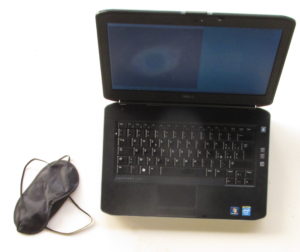
• Edukoi Software (link)
• Computer with webcam and functioning loudspeakers
• First picture of the facade of villa Arrighi (link)
• Second picture of the facade of villa Arrighi (link)
• Image of a spiral galaxy (link)
• Image of a nebula (link)
• Image of Mars (link)
• Eye-patches
Description of the activity
PREPARATION:
Before starting the activity, you should install the Edukoi software on a computer with webcam and speakers. If you like, you can project the images upon a wall (or a screen) by using a projector, so as to make the activity more engaging for the whole group and improve visibility. The activity can be carried out in a group. We suggest a maximum of 20 participants. Please remember to blindfold participants each time the image changes.
CARRYING OUT THE ACTIVITY:
Introduce the idea that this is a laboratory of astronomy, and ask whether anyone knows what astronomers do and how they do it. Possible questions: what do astronomers do? What do they study? How can they study the Universe, which instruments do they use? Astronomers study the Space, the Universe, stars, planets, galaxies, black holes, nebulae, … Someone might answer that astronomers travel into space. Clear up that those are astronauts. Astronomers, on the other hand, stay grounded and study the Universe, using (space and ground) telescopes, satellites, and rovers.
Introduce the idea that we are all used to think that astronomy is a visual science, based upon images and charts. Encourage participants to reflect, and tell them that the data gathered by telescopes are in fact digital numbers. Tell participants that we are used to seeing beautiful astronomical images, whereas what astronomers receive from telescopes are numbers rather than images. Our eyes cannot see most astronomical phenomena. With our own eyes, in the darkest places of the Earth, we can see at most the 3000 brightest stars of our galaxy. The other stars are too far away and their light is too weak to be seen with the naked eye. Moreover, most celestial bodies emit a type of light which our eyes cannot perceive, such as for instance X rays, infrared radiation, ultraviolet radiation. Ask participants whether they know examples of bodies on Earth which emit this kind of radiation. Possible questions: Does anybody know of any object on the earth which emits infrared radiation? If you approach a radiator, what do you perceive? The radiator’s heat, which you cannot see with your own eyes, but you can perceive it on your skin, is infrared radiation. Can anyone make example of a place on Earth where we come into direct contact with ultraviolet rays? When we are on the beach and do not put on sunscreen, what happens? We burn. The Sun’s ultraviolet radiation is what burns us. One of the participants might point out that there is also dark matter. Tell them that dark matter does not emit radiation and therefore, in fact, cannot be seen with our own eyes. The only way to discover dark matter is to perceive its gravitational attraction (namely, the same which holds us down to Earth).
Take up the idea that we cannot see 99% of our Universe. Therefore astronomers receive numerical data and transform them into images (or charts) to make sense of all these numbers. The visual representation of numerical data is only a choice, but we could also use other methods. During this laboratory, we shall transform data into sound. This is a new path that some astronomers are taking: they are exploring the possibility to use the sound in order to represent numerical data, both for research (i.e. discover how the Universe works) both for outreach (i.e. have a good time with the audience, just like we are doing now).
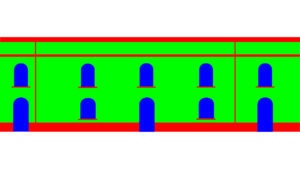
Prepare participants to the following activity: what we will is exploring astronomical data through sound. In order to do that, we will use an instrument called Edukoi, which was recently created by astronomers. Tell them that, when astronomers have a new tool (for instance a new telescope), first of all they should understand whether it works and how it works. This is called “calibration” of the instrument or telescope. We will do the same. We will try to use our instrument (Edukoi) with the data known to us and before our eyes: namely, the façade of Villa Arrighi.
Ask a participant to be a calibrator. Blindfold all participants and the experimenter. Project the image of the Villa’s facade. Ask the participant to explore the image by moving his/her hand in front of the computer’s webcam.
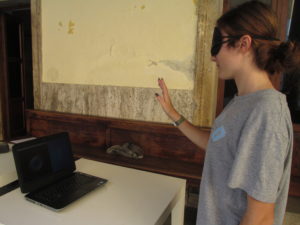
Ask participants to describe what is happening. Possible questions: What do you hear? What happens when the participant passes his/her finger on the windows of the villa and on its facade? What about the doors? What does sound represent? Possible answers: the sound represents the colour. Blue has the sound of waters or bubbles, red has the sound of fire, green has the sound of the forest or of birds chirping.
Ask another participant to replace the preceding one. All are blindfolded again. The calibrator touches a part of the image (doors, windows, or facade) and the others must guess which colour they are hearing. Repeat this phase a few more times.
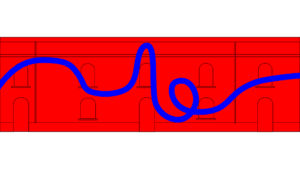
Now calibration gets more difficult. Find a new experimenter among participants. This time on the villa’s facade there is a trace, a curve, a road that stretches from the left side of the villa to its right side. We must follow this road, without leaving the track, that is without leaving the facade. Therefore, the facade has a colour, and the curve has another colour. Participants are once again blindfolded. Ask what colour is the facade of the villa, and what colour is the road. Ask the experimenter to follow the road with his/her finger, and ask the other participants to indicate when it comes out and is once again placed on the facade.
Now that our instrument, Edukoi, has been calibrated and we have understood how it works, we can explore astronomical images. Make clear at once that the space is silent; we cannot hear sounds outside the atmosphere. It takes a means (like for instance air) for the sound to propagate and reach. In the empty space there is nothing, not even sound. Therefore, all the souond which we will hear are our arbitrary choices.
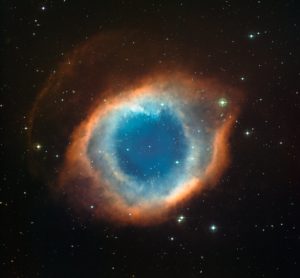
Tell participants that the first astronomical image which we will explore is the Helix Nebula. This nebula formed when a star, similar to the Sun, reached the ends of its life. Ask if any participant knows what the stars are made of.
Stars are made of gas.
When this star became very old, it began to expel its constituent gas into space. In the centre there is only a bright dot, that is what remains of the star (which is now a white dwarf, because it is a small star). This white dwarf keeps heating the nearest part of gas, whereas the farthest gas gets colder and colder. Now with our Edukoi instrument, we will discover what colour is the gas emitted by this star. Ask which participant wants to play the role of the astronomer now and what is his/her name. Ask the others to lower the blindfold and close their eyes. Project the image of the Helix nebula. Ask the astronomer-participant to explore the image with one hand. Ask what colour is the centre of the nebula, what colour are the outermost and farthest layers. Once we hear all the colours together, what kind astronomical object are we exploring?
Tell participants that the hottest gas layers are blue, whereas the coldest ones are red. When we hear all the sound together, we are listening to the white colour. These are the stars present in the image. Make them open their eyes and watch the image. Ask them if what they imagined while listening is similar or different from what they are observing now.

Tell participants that the second astronomical image which we are going to explore is a galaxy. It is called spiral galaxy, because it has the shape of a spiral. Ask whether anyone knows a special spiral galaxy. The Milky Way, our own galaxy, is a spiral galaxy.
Tell participants what is a galaxy: a set of stars, gas, dust, dark matter, planets, nebulae. Ask one participant to come and use Edukoi, and tell the others to lower their blindfold on their eyes. Project the image. Lead the exploration by asking what colour is the centre of the image? And what about the outer zone? Is there really only one galaxy in this image, or is there something else?
Let them open their eyes. Ask once again whether the imagine looks like what they imagined. If there are blind participants, ask the others to describe the image with their own words. Tell them that the large spiral galaxy in the centre of the image is merging with another small galaxy, which appears in the lower-left corner. They are both spiral galaxies, with a red core of old and cold stars, and spiral arms with young and hot stars.

Let us conclude with the exploration of a last celestial body. Find once again a voluntary explorer. Tell participants that it is a planet of the Solar System, but this time they must guess which planet it is. Participants must once again lower their blindfold. Guide the exploration of the image.
Mars is called the red planet because of the colour of the rocks covering its surface. Indeed, these rocks are red. Let participants open their eyes.
Conclude the activity discussing with participants about their emotions during the sound exploration, and their impressions. In particular, introduce the idea that the use of sound (possibly together with pictures) allows everyone, even blind people, to get to know astronomy.
Possible questions: Now that we have almost finished this laboratory, could you tell us what you felt while listening to the sounds of astronomical images? According to you, in which cases can the use of sound, rather than images, be very useful? How can blind astronomers study celestial bodies? Can the blind become astronomers?
Conclude by saying that anybody can become an astronomer, apart from their eyesight. Give permission to test Edukoi to those who could not try it. Greet all participants.
Explanation of the physical process
The process of transformation of astronomical data into sound is called “sonification”. There are many different ways of completing this process. In this laboratory, we decided to associate the sounds of natural elements (water, fire, …) with colours, namely to associate timbres with colours. We could have made a different choice, and associate with colours different frequencies (serious/acute sounds) or different volumes (high/low) or different rhythms (slow/fast sounds). From studies of psychoacoustics, it seems that, in order to classify (for example colours), the most effective method is using the timbre (for instance what distinguishes fire from water, but also the violin from the piano), whence our choice.
Sonification applied to astronomy is still under study and development. It is mainly used for public outreach, but also for school education. It recently started to be used also for astronomical research.
Not only astronomy is starting to use sonification, but also other disciplines (e.g., biology, sismography).

